The Biccard Collection is the collective works of John Biccard, a remarkably talented artist from Cape Town, South Africa who created whimsical sculptures made of crushed marble. In 2015 I stumbled across one of John’s sculptures and became fascinated with his work. However, after searching the internet for information about John and his creations, I found very little about this mysterious artist.
It seems one of the main reasons why it is so difficult to obtain information about John is because he is a very private person. Through my continuous pursuit for information, I was able to uncover the following about the life and work of Mr. John Biccard.
John Biccard was born John Henry Burnwood on the 6th of February, 1941. He was raised in the farm and wineland regions of the Cape peninsula, near the major sea port of Cape Town. John was educated in Cape Town and travelled extensively throughout Europe, spending some time studying at Cambridge in London, England, hence the Euro-centricity of his works. He returned to his native land to carry on with his first love, sculpturing. John is a very private person who liked to be known as “a person who is indigenous of this fair and wonderful part of South Africa,” a true Capetonian (Source: PJ Designs).
According to an old acquaintance; John created his art under his mother’s maiden name (Biccard), as his father did not approve of his profession and wanted him to have a more formal occupation.

John worked in the medium of crushed marble, creating his collection of whimsical sculptures (known as the “Biccard Marbles”) from drawings he had done of subjects that caught his interest and imagination. He started with a pencil sketch of his subject and then formed the finished caricature. John produced a set of 22 “cards” depicting his character sketches (some of which did not make it into a sculpture). Peter Lane, a long time Biccard collector from the UK, purchased his set of cards from Classique in Bedfordview Shopping Mall, Johannesburg.
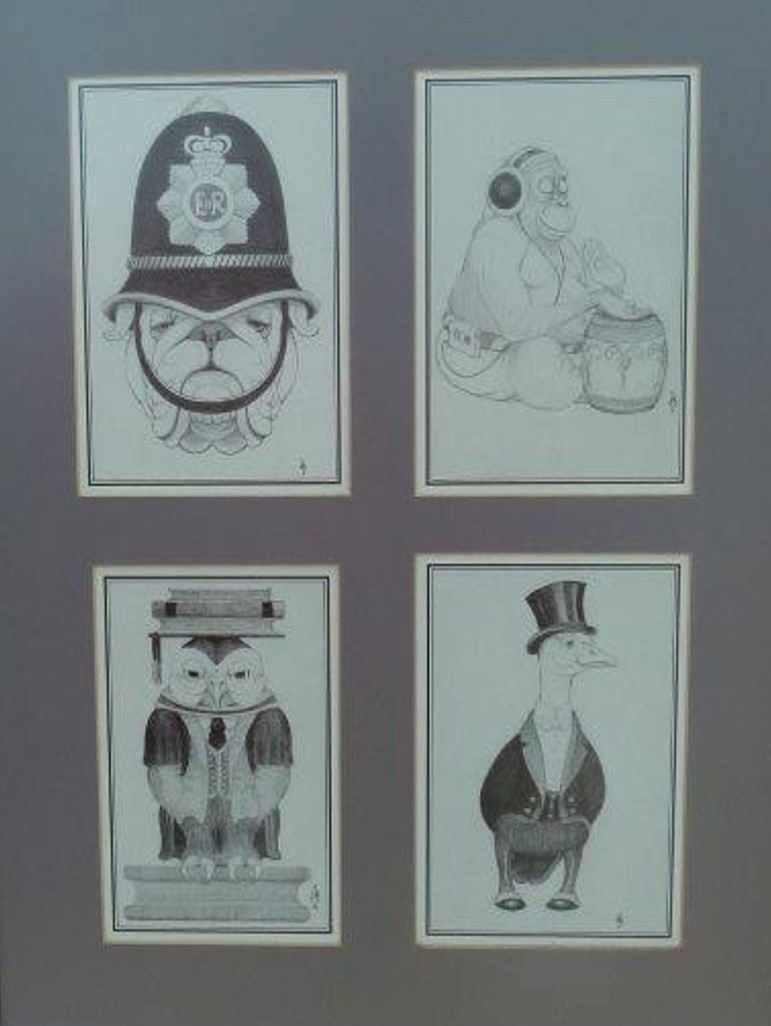
One can tell that John had a great sense of humor that went into his creations. Most of the sculptures are caricatures of animals depicting “important” people or events, such as Cholmondeley “Chumley” the Caterpillar who is smugly awaiting the coming of Spring so that he can turn into a beautiful butterfly, or Phileas Frogg who can be seen sitting by the roadside fishing for compliments (Source: PJ Designs).
In the early 70s John had a studio in Church Street, Cape Town. Through inquiry with Biccard collectors I established that John sold his sculptures in the shop on Table Mountain, in a gift shop at Sun City and in a Décor shop in Johannesburg. John’s charming sculptures are all hand finished in exquisite detail and were produced during the early 1970’s to late 1990’s. In the 1980’s these magnificent sculptures were sold exclusively from Excalibur Art Ltd and came in a brown box denoted with the Biccard Collection insignia on the front. Included in the box was an information leaflet containing a description/story of the specific character and the following standard text; “These pieces are hand created in Mr John Biccard’s studio in modest quantities and are already collector’s pieces. They are intended to be handled, viewed from all angles and to make you smile, thus giving pleasure. Each piece carries Mr Biccard’s monogram. (Direct sunlight may cause colour tone change).“
Each sculpture had a sticker on the bottom that read “Hand made in South Africa.” Unlike other antiques/collectables that can be authenticated by a makers mark or stamp underneath the base, John’s sculptures are visibly engraved with a trademark design of his initials – “JB”.
For the avid collector out there, these sculptures will last a lifetime and more, with only the minimal amount of care. John captures the similarity between man and animal with a sense of humor, yet an air of realism. His sculptures are truly unique handmade works of art with a whimsical touch. Biccard sculptures are becoming increasingly scarce and are highly prized and sought after. In light of this, their value has risen significantly over the past decade.
Examples of John Biccard’s marble sculptures:

Introducing “Sufi (The Magus’s Camel)” from the Biccard Collection
Sufi weighs approximately 800g and stands 11x18cm. This camel has amazing muscular detail to his face, shiny black eyes, a heart-shaped nose (which John seemed to love to do since you see this on a few of the figurines) and a look of pure serenity and satisfaction in his smile. Sufi is wearing a fringed and tassel blanket. He is richly decorated with palm tree’s and etched flowers as the background designs. On one side you see the dolphin and pyramid, the sun and the moon, water and land and sail boat. The opposite side shows the camel walking through the eye of the needle. He is truly Blessed. John Biccard’s initials can be found above both main designs on either side of the camel. The headdress is simple which compliments the ornate blanket. This funky camel is John’s version of the eye of the needle. Read more about Sufi’s features here: http://www.pjdesigns.com/pj/biccard1.htm
Photo credit: Seektiques

Introducing “D’Artagnan” from the Biccard Collection
D’Artagnan is either a Persian or Angora cat with his long fur and is clearly an alias for Puss in Boots. He is wearing a wide brimmed plumed, cavalier hat. Dressed in frilly cravat, waistcoat and boots. If you look carefully at the back, peeking out of his long fur and sash is a sword. D’Artagnan has an eye patch as well. His whiskers are curled into a mustache. John Biccards initials adorn the hat.
Photo credit: Seektiques

Introducing “Pie Face” from the Biccard Collection
Pie Face is one cool chimp! Dressed like he is right out of the 1970’s. He wears a Gatsby or newsboy cap, wide collar shirt with butterfly motifs, diamond cut pattern tie with John Biccard’s initials as the accent. His face is very expressive as you can see. A thoughtful and wise look as though he knows something that we don’t. He has piercing shiny black eyes, a slight smile and heart shaped nose, sideburns like Elvis and long fur over the back of his collar.
Photo credit: Seektiques

Introducing “Prof.” from the Biccard Collection
Prof. is dressed like a scholar and perched on a podium. An exquisite quill pen is the center design. The distinguished P.H.D. hood on Prof’s back shows a spread winged owl with a book. Great detailing has been done to all the feathers. The eyes are grooved out for added depth. The talons are very detailed. John Biccard’s Initials can be found on the left side of Prof’s checkerboard-patterned vest.
Photo credit: Seektiques

Introducing “Red Baron” from the Biccard Collection
Red Baron weighs approximately 200g and stands 8cm high. Red Baron has a wide muzzle and heavy lidded eyes. He is dressed in full flying attire with his flying cap with ear flaps and flying goggles which bear John Biccard’s initials. Two detailed old fighter planes which show a dog resembling Snoopy sitting inside have been carved on either side of Red Baron’s jacket. Carved out in the center on the back of his jacket is “The Red Baron.”
Photo credit: Seektiques

Introducing “Sherlock Holmes” from the Biccard Collection
Sherlock is a super sleuth! With his keen sense of smell, intelligent eyes, this hound is great. A reverse of The Hound of the Baskervilles. Another one of John Biccards whimsical antics to his figurines. Sherlock is dressed in his deerstalker hat and overcoat both done in a checkered pattern. The detail on this bloodhound is just amazing. The hound has deep folds in his face, deep set eyes and long ears that protrude from under his cap. John Biccard’s initials can be found on the back of Sherlock’s coat.
Photo credit: Seektiques

Introducing “Napoleon (War) and the Saint (Peace)” from the Biccard Collection
These miniature pieces were sold together as a package and symbolize war and peace.
Napoleon is John Biccard’s artistic take on Napoleon Bonaparte, Emperor of the French. Napoleon stands 8.5cm high and 4.2cm widest at the base. The piece is named “War.” He is dressed in his finest uniform; the jacket has fringed epaulets and six buttons down the front, he has high military boots and a large bicorn hat with a ribbon. His Jacket is cut away exposing a very round belly. If you look closely, you will notice he is pigeon toed. Napoleon’s face has the look of determination. This is a fabulous depiction of the man himself with all the details picked out and brilliantly executed from a few wisps of curls under his hat to the arms folded behind his back. John Biccard’s initials can be found carved into each pocket.
The Saint is named “Peace” and is depicted to be the opposite of Napoleon (War). As you can see, Saint has the look of tranquillity. Dressed in a checker board cape with varied patterns. Saint’s robe shows earths bounty with grapes, bananas, pineapple and apples. In addition to these, there are also flowers and a butterfly. The inside brim of the hat shows bunches of grapes. Four doves adorn the outside of his hat; two dove’s holding an olive branch – a symbol of peace and harmony, the other two doves I assume symbolize love. This man is holding his belly. Which could very well be representational of mother earth or he is full with nature’s gifts. Whichever way you look at him, he is blessed. John Biccard’s initials can be found inside the apple on Saint’s robe.
Since each sculpture was hand made by John, they were issued as Limited Editions only. No two are exactly alike. Colours may vary from sculpture to sculpture; some sculptures have a brown shading, some have black detailing drawn or painted on and others seem to be plain white. The colouring can easily be mistaken for ivory or bone at first glance, but once you lift the sculpture up, they are relatively heavy considering their size and cold to the touch. The colour variations can be seen below in the two examples of John’s orangutan sculpture named “Dolby.” Orangutans are intelligent and for the most part, peaceful animals. This is how John portrays Dolby, his orangutan. This ape appears to be meditating in a yoga position, complete with a headset. Dolby’s facial expression is serene and it is evident that he must be listening to some very relaxing music. The attention to detail is superb. With his arms folded across his belly, Dolby resembles an ape-like Buddha.
There are also variations in the types of marble sculptures John created. The majority are full bodied characters, however he also created busts, animal heads fixed on a stand, bookends and what appears to be a rhino horn dubbed “Queen (Her Royal Rhiness).” Below is John Biccard’s “Lawrence of Arabia,” an example of one of the animal head on a stand sculptures John made. It is 23 cms in height and comes with a copy of Lawrence’s “CV” (Source: Skyscraper Cape Town). These witty little stories were originally sold with each sculpture.
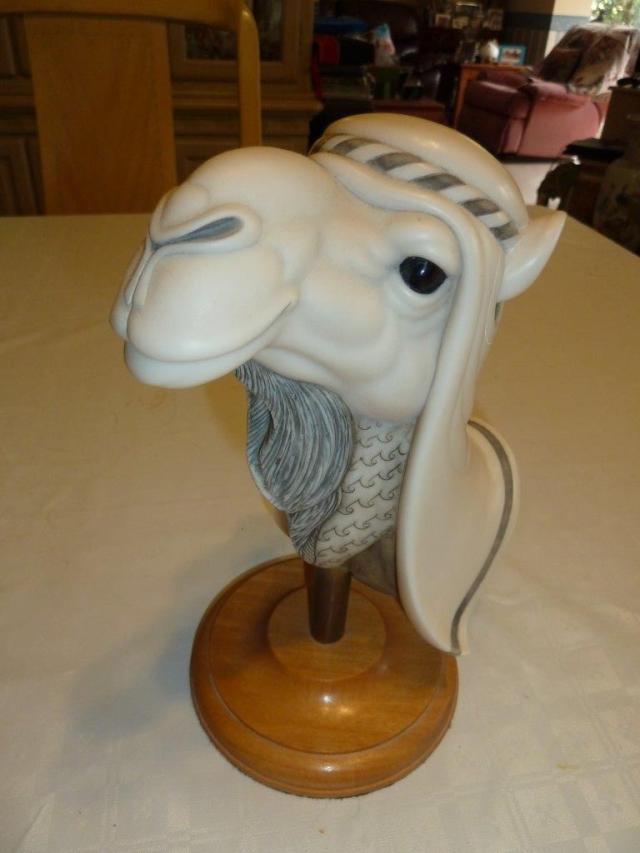
According to long time Biccard collectors Joan and Steven Pye, “when John first created his sculptures he valued his work on the size of each piece, the work involved and of course the amount of crushed marble required to produce each piece. We believe his works on the stands were his latest creations and Lawrence of Arabia was one of his last. We also believe that Lawrence of Arabia is one of John’s finest sculptures.” John wrote the following poem about his camel sculpture:
“Sufi, the magus’s camel,
was a remarkable mammal,
as at home in a busy bazaar
as alone on a dune with a star.”
– John Biccard
Photo Credit: Peter Lane
One of the most intriguing sculptures John created was his marble chess set. Each chess piece is designed in John’s own unique style. John also wrote a book in 1972 entitled “Insulting the Pawn” which was around the time he was working on “prototype” designs for the chess set. The book was published by J. Burn Wood 1972 “Watergang”, Stellenbosch, Cape and apparently has a reference to The Grand Master Boris The Russian Bear which is presumed to refer to Soviet chess grandmaster Boris Spassky. It does not look like a conventional book; it has been described as 11 sheets of A4 sized pages “sandwiched” between two A4 sized cardboard covers in “Landscape” orientation. In John’s own words, it describes his thoughts during the process of carving his 6 prototype chess sets. It also gives an insight into his personality with some amusing “expressions” and poetical statements.

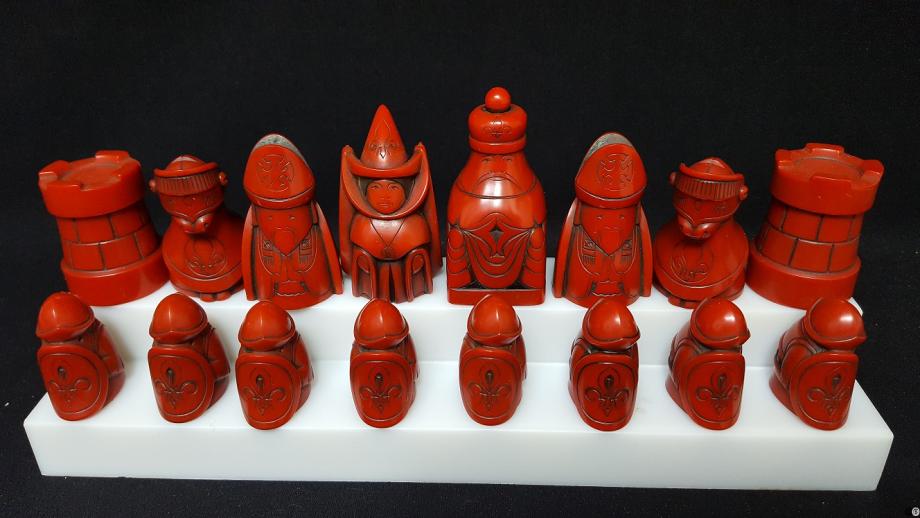
John’s marble sculptures can be evaluated using the criteria below:
- The rarity of the sculpture – Some characters are more rare or sought after and are not often seen for sale, thus making them more valuable. It is uncertain if John made a limited number of certain characters, thus making them more difficult to acquire today.
- The size of the sculpture – From my research, I have established that John charged more for larger sculptures and less for smaller sculptures, this was due to the amount of crushed marble he utilised and the amount of effort taken to make the sculpture.
- The condition of the sculpture (all of the points below can effect the value of a sculpture):
- Colour tone of the marble – if the sculpture has been exposed to the sun then the color of the marble can become yellow.
- Damages to the marble – if the sculpture has any scratches or chips to the marble. The placing of the chip and the size of the chip can impact the value differently (e.g. if the chip/ scratch is underneath the base of the sculpture, then this will not impact the value very much, however, if the chip/ scratch is on the sculpture’s face or easily noticeable when displaying the sculpture, this can impact the value significantly. The same goes for the size of the chip/ scratch; the larger the chip/ scratch, the more impact it will have on the value of the sculpture).
- Fading of the black detail/ shading – over the years when the sculptures are handled or cleaned, the black shading/ detailing often becomes faded and not so prominent. You can do a comparison of your Biccard sculpture/s with the mint condition sculptures displayed on the official John Biccard website.
During my research I discovered that five Biccard sculptures have not been included on the official John Biccard website. This leads me to believe that there may be more John Biccard sculptures out there. The sculptures which are not on the website are displayed below.



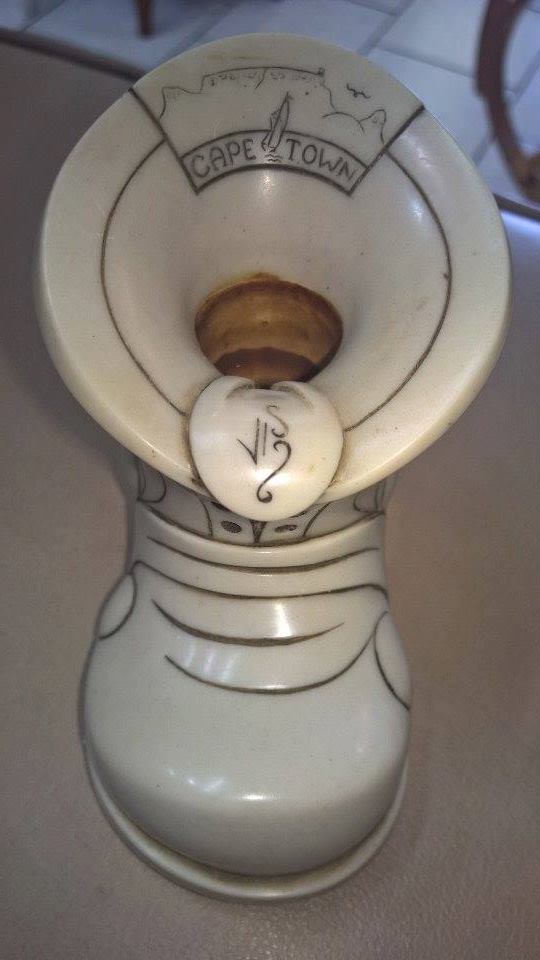

Another unique sculpture John created is the Pablo sculpture (see below). According to Janice Cocks, in the early 1970s her mother worked in the center of town and found John’s studio on one of her lunch time explorations. “She took a liking to him and used to pop in to his studio. She seemed to get to know him quite well. The Pablo sculpture is actually a self-portrait John created. Looking more closely at the photos of John, there is definitely a resemblance. John was obsessed with getting both halves exactly the same. He felt that no one would buy this item, so it is uncertain how many are in existence.” Through my time collecting I have come across several of these sculptures, so there does seem to be quite a few out there.

Production of the “Biccard Marbles” ceased in 1999. According to unaccredited internet sources, John passed away seven years later in 2006. However, there is no evidence to substantiate this claim on the John Bicccard website (which was created in 2012 and is regularly updated with new content). During my research I came across an issue of the National Gazette which stated that John Henry Burnwood (Born 6 February 1941) legally changed his name to John Biccard on the 5th of April, 2012 (Source: National Gazette No 35212, 05 April 2012, Vol 562 (Part 1, 2), Page 11). John Biccard also has active user accounts on Pinterest (member since May 2012) and Goodreads. However, it seems that John’s close friend Christopher Burton-Thomas (known as “Blue”) posts on these platforms on behalf of him.

Photo Credit: Denise
John’s last known physical address was previously listed on the John Biccard website as 17 Pastorie Street, Prince Albert, Western Cape, 6930. His user profile on Goodreads provides us with some insight into what he may be getting up to today:
“Interests:
Books, gardening, sailing, horse riding and classical music – Mozart, Beethoven, Corelli, Handel.
Favorite books:
Physics, cosmology and the perennial philosophy.
Favorite Authors:
Shakespeare, William Blake, Jane Austen, P.G. Wodehouse, Lewis Carroll.
Born in Cape Town. School – Diocesan College (Bishops). Graduated at University of Cape Town. Taught for 3 years at a private school. Then invited as a guest to sail around the Mediterranean on a yacht. Collected BMW motorcycle in Valencia and traveled extensively around Europe, the Greek islands and the Middle East including Syria, Lebanon and Egypt. Returned to Cape Town and joined the editorial department of Oxford University Press in Cape Town for 3 years. He then went to live on the Greek island of Patmos to write poetry. On returning to Cape Town became an artist and went to live on a beautiful wine farm in Stellenbosch. Then returned to Cape Town to live in Clifton above the famous Clifton beaches. He now lives in the Great Karoo in the Western Cape with his two much loved horses; Chumly and Darcy and two resident Cape Eagle owls; Owlbert and Victoria. He is currently writing more stories.”
John imprinted a small piece of himself in each one of his creations that have since made their way around the world. Today these marble sculptures are highly valued by those who own and love them.
Visit the official John Biccard website to see a full display of John’s graphic designs, drawings, animal cartoons and The Biccard Collection of bonded marble sculptures and chess pieces. The site also offers downloadable eBooks which cover interesting stories written by John. One in particular is Chessablanca, a light-hearted romantic and courtly fantasy.
About the Author
Born in East London, South Africa, Dayne Skolmen developed a passion for writing articles in his early 20s. His favourite subjects to write about are interesting people, places, and items from the past. With every article he writes, he discovers all the details about his subjects and pieces them together to form a brief history for you to enjoy.
For more articles visit Dayne’s Discoveries Blog, like Dayne’s Discoveries Facebook Page to keep updated with new publications, join the John Biccard Collectors Facebook group or Contact Dayne to have your Biccard sculptures appraised, or to share any information, stories, or photographs relating to John Biccard.




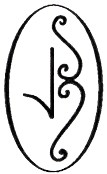
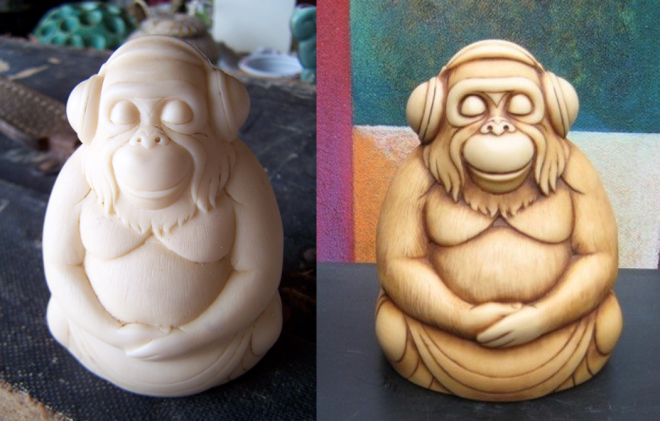
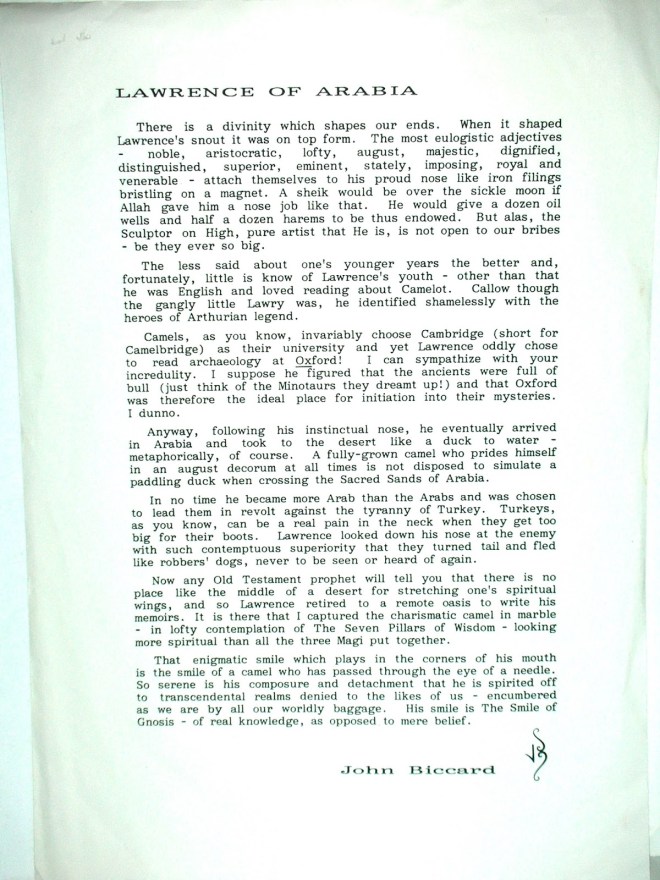

I have almost the entire range of figurines but desire to own the complete chess set should anyone have same, i offer R5000
LikeLike
I have nine pieces and my son has a full chess set (Eastern – I think Chinese pieces), possibly war figures. My son also has the chess board – leather and brass and signed by John Biccard. My pieces which are all reflected on the various websites seem to have faded when I look at the pictures. My father-in-law retired to live in Cape Town and he bought many pieces – starting in the early 1980’s. When he and my mother-in-law passed away, their own collection disappeared. My father-in-law also bought pieces as gifts for friends. I found a publication called “Romulus” personally addressed to my father-in-law and signed. I was informed that John Biccard had emigrated to Australia and I never took any interest in who had sculpted them until I found the Romulus booklet and my son told me all about John Biccard. His chess set is in beautiful condition, but three figures were slightly damanged in a previous move. This has truly been a revelation in my retirement!!! Thank you for all the information!!
LikeLiked by 1 person
John Biccard is very much alive and well . Met him recently and had a great catch up
LikeLiked by 1 person
Hi,
Thank you for a very interesting site. I lived in Cape Town around 1972 and acquired Cholmondeley and D’Artagnan. I am attributing their acquisition to that period of my life as I married a Wild Irish rover and we travelled the length and breadth of South Africa so I can’t be 100% certain. I have always cherished these two statuettes as Chumley reminds me of my Irish MIL.
I am currently visiting my son in the UAE and came across the link on Face Book quite by chance and am delighted to discover who the artist was or is. I shall definitely have a look at the trading site on Face Book.
LikeLiked by 1 person
I have stumbled across your very informative site whilst trying to find info on my John Biccard collection. I lived in Bedfordview from 1985 to 1989. During that time I collected quite a few pieces of John’s. When I left S. A. To return to UK.my friends bought me the two Rams head book ends. I have a further 15 pieces. They are very much admired in UK.
LikeLiked by 1 person
Hi Christine,
Great to hear from you. Please join the John Biccard Facebook group and post some pictures of your collection. The group is a central place for all Biccard collectors to chat, buy, sell and trade John Biccard sculptures. I have some of my doubles listed on the group, and I often travel to the UK for work, so perhaps you may want to purchase or trade to grow your collection. Here is the link to the Facebook group – https://www.facebook.com/groups/451630868570866/
Kind regards,
Dayne
LikeLike
would like to buy the napoleon if anyone is seling
LikeLiked by 1 person
Are you still looking for Napoleon? I have several (8) pieces for sale.
Are you in South Africa?
LikeLike
Hi Cecelle, I am interested in buying John Biccard figures if you have more for sale.
Regards
Johnny
LikeLike
Hi Johnny. There is a group on Facebook called ”John Biccard Sculptures (Buy, Sell and Trade)”. I suggest joining the Facebook group at the link below, as there are many people selling Biccard sculptures: https://www.facebook.com/groups/451630868570866/
LikeLike
I have a collection of John Bicards work for sale consisting of 20 different pieces.
LikeLiked by 1 person
Hi Patrick. Can you please send me photos of your collection so that I van evaluate the characters you have and their condition. You can contact me here: https://daynesdiscoveries.com/contact-2/
LikeLike
Thank you for letting us know about John Biccard my mum has got a few artifacts of John which we never much took notice of, but this is an eye opener.
LikeLiked by 1 person
Hi Frank. I am glad you found my article informative. May I ask which sculptures your mom has and where she got them from? Looking forward to hearing from you. Regards, Dayne.
LikeLike
i live in singapore and have a bananaparte, could not find more, enjoyed your article.
LikeLiked by 1 person
hi, seth from singapore, a wonderful read, cheered me up a great deal… thank you
LikeLiked by 1 person
Hi Dayne, I stumbled across your website when trying to value my John Biccard “Chumley” caterpillar which a friend of mine gave me when I lived in Johannesburg. He has since left the country, but was a close friend of John’s and told me much about John. I will endeavour to contact him and see if I can get info on his whereabouts.
LikeLiked by 1 person
Hi There.
Thank you for the comment. I would be very interested to chat with your friend about John. I am always updating my article with new information I acquire from people selling Biccard sculptures or those who own magnificent collections and knew John personally when they purchased the sculptures from his studio in Cape Town. Please provide me with any information you may have, I will send you an email so we can chat. Look forward to hearing from you.
Warm regards,
Dayne
LikeLike
Wow, it would be great if you could find John. Mum would love to have contact with him.
Please carry on keeping us in the loop.
Best wishes in your quest
Janice Cocks (not Cook)
Sent from my BlackBerry® wireless device
LikeLiked by 1 person
I have the cricketer and my ex has two of the dolby figurines.
LikeLiked by 1 person
Just read your blog on JB I found it very informative and interesting.
LikeLiked by 1 person
My mom was very fond of John and would love to contact him. She has a wonderful sculpture of a courtesan lying on his tummy, a keyring depicting a racing car and 2 handbag mirrors with the bishop and the cock. How do we get hold of him? Janice & Jill Malleson
LikeLiked by 1 person
Hi Janice. Great to hear from you. According to unaccredited internet sources, John Biccard passed away in 2006. However, I am not entirely convinced by these statements, as I think the they may have been used as a marketing tool when selling John Biccard sculptures. I did send a letter via post to the address in Prince Albert, Western Cape listed on the John Biccard Website, but I have not received any response as of yet. Did your mom know John or was she just fond of his work? I would love to see pictures of the items your mom has.
LikeLike
Hope you find some of his work. Have you tried Stephan Welz Auctioneers? Facebook is a good way to start as well. I had an statue that no one knew who the artist was and within 5 minutes after posting a picture someone contacted me to give the details of the artist. You can also post on the facebook page ‘Vintage Nook and more’ which is created for those seeking. In the meantime I will keep my eyes and ears open.
LikeLiked by 1 person
Thank you for a well written Article about a Brilliant Person .
LikeLiked by 1 person
Very interesting article. Thank you!
LikeLiked by 1 person
Im so proud to say you are my friend!
LikeLiked by 1 person
Thank you, Dayne, for addressing the dearth of information on Mr John Biccard. It seems his quest for privacy is one of the Biccard traits, but it is now right that you honour his remarkable creative talent.
LikeLiked by 1 person
Thank you very informative
LikeLiked by 1 person